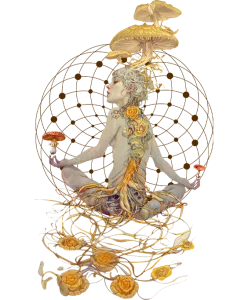In recent years, the rise of psychedelic therapy has brought a renewed focus on the importance of psychedelic integration practices. For those who have experienced profound psychedelic experiences, the need to make sense of and incorporate these insights into daily life is critical for achieving long-lasting benefits. Psychedelic integration therapy is the process of reflecting on and applying the lessons gained during non-ordinary states of consciousness to foster personal growth, emotional healing, and spiritual development.
Psychedelics such as magic mushrooms, LSD, and MDMA have shown great promise in the treatment of depression, anxiety, PTSD, and other mental health conditions. However, without a proper process of integration, the therapeutic potential of these substances may remain untapped. This article will explore the definition of integration, the various tools and practices available, and why it is a vital part of the healing process following mystical experiences and other altered states induced by psychedelics.
Defining Psychedelic Integration
Psychedelic integration is the practice of reflecting on, processing, and applying the insights, emotions, and revelations that arise during a psychedelic journey. After encountering non-ordinary states of consciousness, which often involve vivid mystical experiences or profound emotional breakthroughs, the task of integration becomes essential.
The process of integration involves translating these transformative experiences into tangible changes in thought patterns, behaviors, and emotional well-being. This practice is often facilitated by therapists, mental health professionals, or integration coaches who are trained in guiding individuals through the ongoing emotional and psychological work that comes after the psychedelic journey. Psychedelic integration therapy offers a therapeutic approach that helps individuals understand and integrate the healing potential of psychedelics into their everyday lives.
The Importance of Psychedelic Integration
The healing process following a psychedelic experience is an ongoing process that often unfolds over weeks, months, or even years. Integration allows individuals to create a deeper understanding of the insights gained during their journey and apply them to their personal lives, relationships, and emotional healing. Without integration, even profound experiences may fade over time or leave individuals feeling confused or overwhelmed by their emotional or spiritual revelations.
For many, psychedelics can be a tool for healing, offering access to deep parts of the psyche that may have been repressed or inaccessible through traditional therapeutic methods. This is particularly true for those working through a traumatic experience or addressing long-standing mental health challenges. However, the therapeutic potential of psychedelics can only be fully realized through careful reflection, ongoing support, and the practice of integration.
Common Psychedelic Integration Practices
There are numerous ways to engage in psychedelic integration. Each practice offers a unique approach to grounding the insights gained from mystical experiences or other altered states of consciousness.
1. Journaling for Self-Reflection
Journaling is one of the most widely used tools for integration. Writing about the experience allows individuals to explore their emotions, thoughts, and visions in detail. Journaling helps to document key insights, recognize patterns, and understand how the psychedelic journey has influenced their perspective on life.
This practice is especially helpful in tracking how emotional and psychological changes evolve over time. By revisiting journal entries weeks or months after a journey, individuals can gain a broader view of their growth and the lasting effects of their experience.
2. Therapeutic Support
Psychedelic integration therapy is a structured and supportive form of therapy that helps individuals process their psychedelic experiences in a safe, guided environment. Integration therapists assist in translating the emotional and psychological content from the non-ordinary state into actionable changes that can be applied to daily life. This may include exploring unresolved trauma, discussing difficult emotions that surfaced during the journey, or working through lingering questions about the mystical experience itself.
For individuals who have experienced challenging experiences during a psychedelic session, integration therapy can help make sense of those challenges and guide them toward healing. Therapists trained in this modality understand the delicate nature of psychedelic work and can provide a space for safe, compassionate processing.
3. Meditation and Mindfulness Practices
Meditation and mindfulness are powerful integration tools that help individuals stay connected to the present moment and ground the lessons learned during their journey. By cultivating mindfulness, individuals can observe how the emotional and psychological changes from their psychedelic session are influencing their daily lives.
Breathwork and mindfulness exercises help individuals maintain a calm and reflective state, which is especially useful for managing any anxiety or emotional turbulence that may arise post-journey. These practices promote a sense of peace and clarity, making it easier to integrate insights and foster a positive life.
4. Creative Expression
For some, expressing the psychedelic experience through creative outlets such as art, music, or dance can be a powerful way to integrate. Creative expression externalizes the deep emotions, visions, and ideas that arise during a journey, allowing individuals to process and understand their experiences in a non-verbal way.
Many people report that psychedelics ignite a surge of creative energy, prompting them to paint, write music, or engage in other forms of artistic expression as a means of working through the healing intelligence of their psychedelic experience.
5. Integration Circles and Group Support
Group support is another valuable component of the integration process. Integration circles allow individuals to share their psychedelic experiences with others who have had similar journeys. This form of collective support provides a sense of community and belonging, which can be incredibly grounding after a deeply personal or emotional psychedelic session.
Hearing others’ experiences can provide new perspectives and offer validation, especially when someone has gone through a difficult or confusing journey. This community-based approach to integration can deepen one’s understanding of the human experience and promote shared healing.
The Role of Mental Health Professionals in Integration
For those who use psychedelics in therapeutic settings, such as those undergoing psilocybin-assisted therapy for the treatment of depression, the role of mental health professionals in the integration process is essential. Integration therapy, facilitated by qualified professionals, ensures that individuals are supported throughout their healing journey.
In clinical settings, individuals may experience profound changes in their outlook on life, their relationships, or their emotional resilience. However, without the guidance of therapists or coaches, these changes may not be fully understood or utilized. Clinical studies have shown that when integration is paired with psychedelic therapy, the long-term benefits are more pronounced. Participants in these studies often report lasting reductions in depression and anxiety, as well as increased emotional and spiritual well-being.
Integration: An Ongoing Process
It is important to note that psychedelic integration is not a one-time event but rather an ongoing process. For many individuals, the lessons learned during a psychedelic journey continue to unfold over time, requiring repeated reflection and engagement with integration practices.
This is particularly true for those who have had mystical experiences or encounters with deeply spiritual or existential material. These experiences often challenge an individual’s worldview or sense of self, necessitating long-term reflection to fully comprehend and incorporate these insights into daily life.
By engaging with psychedelic integration as an ongoing, iterative process, individuals can maximize the therapeutic potential of their psychedelic experiences and foster enduring emotional, psychological, and spiritual growth.
Conclusion
Psychedelic integration practices are an essential component of the healing journey for individuals who use psychedelic drugs for personal growth, emotional healing, or the treatment of depression and other mental health conditions. Whether through journaling, therapy, meditation, or community support, the process of integration ensures that the insights and lessons gained during non-ordinary states of consciousness are applied meaningfully in everyday life.
With the help of mental health professionals, creative practices, and structured reflection, individuals can harness the healing intelligence of psychedelics to create lasting positive change in their lives. As research into psychedelics continues to grow, the emphasis on integration will become increasingly important, as it offers the key to turning transformative experiences into a tool for lifelong healing


